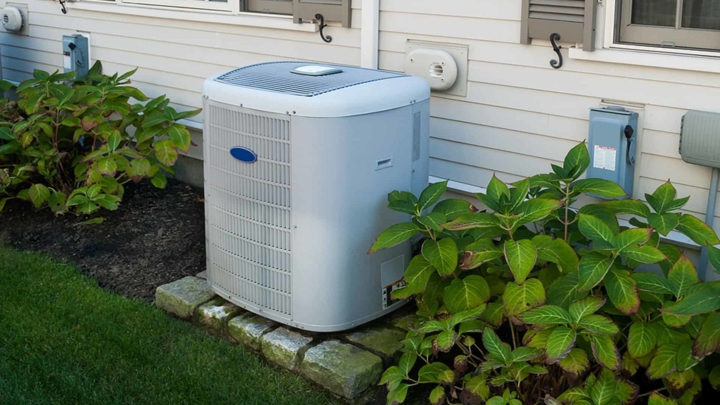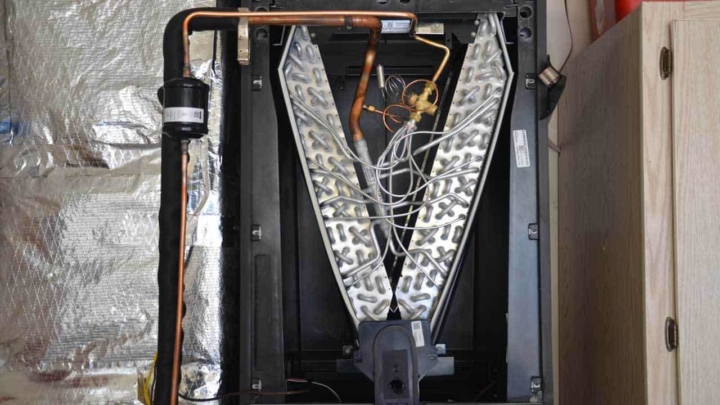Many of us didn't grow up with air conditioning, so we're not familiar with the various components that make up a central air conditioner. We're used to fans, from small ones that sit on a desk to floor models and ceiling fans that are very popular, especially in southern states.

That means buying a new air conditioner is more challenging with new concepts and terminology to learn, so you can make decisions with confidence. And even if you're familiar with one type of air conditioner, there are times when you'll have to learn about a different type of air conditioner which happened to me.
We've used whole house fans for many years in the northeast. That's why I'm learning about central air conditioning now that we own a house in the desert near Phoenix, Arizona. We have a heat pump which provides air conditioning in the summer and heat in the winter. When heat pumps are installed on the roof of the house (the installers didn't think our town allowed this), the entire system is integrated.
Our central air conditioner is called a vertical system because it stands up, where attic and roof installations lay horizontally.


Ready to learn about all the components that make up your HVAC system … except the ductwork as that's how the warmed/cooled air gets distributed through your house.

Anatomy of a Central Air Conditioner
When you look at your HVAC system, you only see two boxes – one that sits outside your house, and the other inside your home in the garage, attic or basement. The outside components box is called the condenser while the inside box is the air handler. But you need to understand what's inside these boxes, to learn how your central air conditioner works.

Here are the key components (numbered above) making up any HVAC system, with a brief description of what they do. To help you get a better view, there are also photos of each component taken during the installation of my new heat pump.
- Evaporator – super cool refrigerant flows through the evaporator coils and removes both heat and humidity. The heat is absorbed by the refrigerant and PVC piping takes the water removed from the air. The water drains outside using gravity or in some cases, a pump.
- Blower (or fan) – pulls the air from your house into the air handler where it circulates the air over the evaporator coils to cool it (or heat it when you have a dual purpose heat pump). The conditioned air moves upward and out to your house through the ductwork.
- Condenser – has coils around the outside of the box to circulate the refrigerant from the air handler. The heat absorbed by the refrigerant is then released into the outside air, which is why this box is always found outdoors.
- Compressor – is the heart of your HVAC system, pumping refrigerant through the closed loop between the evaporator inside and the condenser outside your home. The refrigerant changes between a liquid and a gas, moving heat between your house and outdoors.

Your HVAC's compressor is installed outside where it releases heat …
- Outside fan – blows air over the condenser coils to release (in tech speak, the word is dissipate) the heat into the outdoor air for air conditioning. When a heat pump is operating in reverse, the same refrigerant absorbs heat from the air and it moves inside to heat your home.
- Return air grill and filter – intake vent has a grill and inside a filter to prevent objects in the air from clogging or damaging the components making up your system. The reason you need to replace the filter frequently is to make sure enough air reaches the air handler, so your HVAC system runs efficiently.
- Thermostat – mounted on a wall in your house, monitors air temperature and depending on your settings, sends a signal to start or stop the HVAC system from operating.
- Line set – refers to the pair of copper refrigerant lines running between your condenser and evaporator coil, located inside the air handler cabinet. They're different sizes (set by manufacturer) and only the larger suction line carrying refrigerant as a vapor needs to be insulated. The smaller liquid (state of the refrigerant) line does not need to be insulated. Confused? Here's a video on Refrigerant Line Set Sizing.
- Condensate drain – is the white plastic (PVC) pipe that runs from the evaporator coil to a drain using gravity or a pump.
- Plenum and ductwork – The plenum is the metal box attached to the supply outlet of your HVAC equipment, that distributes conditioned air to the ductwork. The ductwork distributes the air to individual rooms of the house.










How often should a central A/C or HVAC system be serviced?
How often should HVAC filters be replaced?
How can thermostat settings save money?
For added savings I lower the thermostat when I leave the house for 4/more hours. In Florida that means 86 degrees and it takes about an hour to recover once I get home.












Thank you for simplifying the anatomy of an ac system. I appreciate the lovely blog.
Glad you found it helpful as truly, the HVAC system is the most difficult to understand … and I had to learn a lot when my systems had to be replaced (read: Why You Can’t Trust Home Warranty Companies to see what drove me to write this article).
Hello Tina, thank you for the lovely blog. The information provided clearly and simply explains the anatomy of an AC system. The technician at Lee’s Air, Plumbing, & Heating provided a detailed invoice while servicing my AC unit in Fresno, CA and explained everything but I needed another refresher when reviewing the invoice again. It is cool to see how much goes into cooling you home and the simple ways to save money like changing the air filter when it gets dirty.
Nice article, thanks for providing such informative content with us. I’ am looking for such more articles.
It’s good to know that getting an HVAC system that’s too large or too small for our needs could waste energy. Our system is getting pretty old and doesn’t work well anymore, so we’re probably going to be looking for a replacement pretty soon. We’ll definitely have to ask for a recommendation on what system would be right for us. After this kind of article, people can learn a lot of new things and with the knowledge they have acquired, they can maintain their HVAC system very well.
Hello Tina. Thanks for the great explanation of parts and the workings on the ac unit. Quick question. When looking for how the the ac intake area should look like, how it should generally be constructed and with what materials. I noticed in my moms house the box where the ac intake is, is all wood. I have asthma and I can’t see why that would be helping me. Any advice for us allergy sufferers out there. Thank you.
Liane, I’m not sure what you mean by a wood box. The HVAC systems I’m familiar with pull air from inside your house through a large metal grill, and behind the grill is ductwork that is used throughout the system. Okay, that’s when the intake isn’t near the air handler so …
I just checked my current system and the walls are drywall but the box has roughly 1 inch thick padding around it to keep the air once it passes through the filter, clean.
I can’t seem to find a link to upload the pic of my moms ac intake closet. The ac gets pulled into a enclosed wooden box and then goes up into the ductwork. With the research I did online, seems that area is called a pc intake plenum. Though this wood box is not lined with anything, just pure wood.
Haven’t seen any online that look like this, and am wondering if some of my allergies are worsened by this, being wood is porous and can hold onto mold spores.
Have you ever heard of this before??
I loved it when you said that many of us didn’t grow up with air conditioning, so we’re not familiar with the various components that make up a central air conditioner. My brother’s air conditioner has a problem because of its loud noise. I will recommend to him to look for an air conditioning repair service to address the issue. Or find HVAC parts and supply to where he can buy the damaged parts.
Jeff, Your brother might be able to fix an older HVAC system but honestly, all new house appliances/systems are built using electronics (cars too) making DIY repairs almost impossible.
Thanks for explaining things clearly! We just had our AC installed and I wanted to get familiar with all the parts so I’ll know how to take care of it properly. The guys from Anderson Air also explained to me the basic things I should do as to how I can clean and maintain the condition of my AC. They did a pretty good job with the installation. You can read more about them here.
Thank you so much for the clear explanations! I could not for the life of me figure out what that big AC unit is that sits in my attic; I’ve only known about the condenser unit that sits outside my house. :)
Stephanie, Glad this article helped you. It was very challenging to write but I knew if I was confused, too many other homeowners also didn’t understand enough. Fortunately as homeowners, we only need to know how to change our HVAC filters and if you live in a southern, humid state … you also need to learn to clean out the condensate line.
It’s a really great article, thanks for sharing such informative knowledge with us.
Ms.Tina,. You are more than welcome ! Your explations/ knowledge were easy to understand. You are helping a lot of women like me ,who live alone,and know little about home equipment functioning. Thank you!
Laura, Glad I could help & please leave a comment when you don’t understand something … and share this website with your friends.
This was very helpful and interesting!